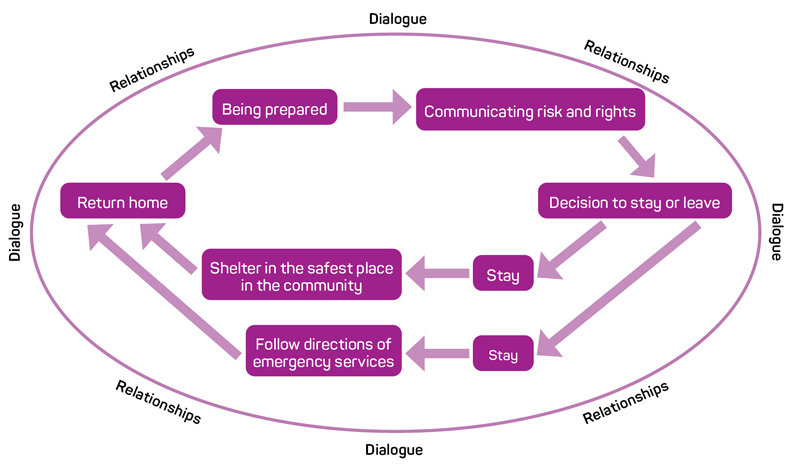Evacuations are challenging for anyone who experiences them, however, Indigenous peoples and communities have distinct needs and can face additional risks throughout these processes.
Recognising a gap in policy and practice guidance regarding the evacuation of Aboriginal and Torres Strait Islander peoples and communities, the National Indigenous Disaster Resilience program, supported by the Australian Institute for Disaster Resilience (AIDR), developed the Planning Evacuations with Indigenous Communities Guide (Evacuation Guide) as a companion document to the Evacuation Planning handbook.1 The AIDR Handbook Collection provides authoritative knowledge and guidance on national principles and practices for disaster resilience.

Decisions by emergency management personnel to evacuate a community are based on a suite of complex and interconnected factors. Making the decision to evacuate can be equally complex for community members. For Indigenous peoples and communities, these complexities are deepened because of factors that uniquely affect them.
In developing the Evacuation Guide, particular consideration was given to the ongoing traumas that colonisation inflicts on Indigenous people across Australia, and the need for research, policy and practice that is trauma-informed and centres on healing.2 The Evacuation Guide was developed with this in mind and encourages social rather than solo processes, strengths-based and community-led processes as well as the need for socially and culturally safe spaces. These are key elements of Indigenous healing.3
Of equal importance are Indigenous peoples’ unique connections and relationships with Country4, which is in contrast with non-Indigenous settler understandings of ownership.5 When Indigenous peoples are instructed to evacuate, this can be a complex and difficult decision and consideration may be given to responsibilities to Country and cultural heritage as well as homes and property.
The Evacuation Guide acknowledges the critical role Aboriginal Community-Controlled Organisations play in supporting Indigenous communities during and after disasters, acting as first responders and the main provider of immediate relief, support and safety.6
| Know and respect peoples’ rights |
| It is important that rights, including those recognised under the United Nations Declaration on the Rights of Indigenous Peoples, are not neglected or dismissed in emergency situations. |
| Foreground connection with Country |
| Indigenous peoples and communities have deep connections to Country which should be respected and prioritised. |
| Work within existing community governing institutions |
| Knowing and working within community-controlled organisations and institutions respects existing arrangements and is critical for working with communities effectively. |
| Provide a safe and welcome environment for Elders |
| As community leaders and knowledge holders, Elders should be engaged early and respectfully, and feel safe and welcome throughout evacuation planning and implementation processes. |
| Acknowledge the sanctity of family |
| Family and kinship are essential to Indigenous peoples’ cultural identity and it’s important that this is acknowledged and respected. |
| Relieve anxiety, don’t add to it |
| Emergencies are stressful for anyone involved, however, it’s important that people are given information in a calm and respectful way so that they can make informed decisions. |
Figure 1: Principles outlined in the Evacuation Guide.
Cross-jurisdictional application
The Evacuation Guide takes a principle-based approach to planning and executing evacuations with Indigenous peoples and communities using processes that are safe and effective. The guide is intended to support evacuation planning and implementation processes that involve Indigenous communities and communities with high Indigenous populations in remote, regional and urban settings.
In Australia, emergency management arrangements and laws are complex and vary across state and territory jurisdictions, which hold primary responsibility for emergency management. The Evacuation Guide is structured to enable broad application. The Evacuation Guide is underpinned by 6 principles (see Figure 1) to be considered and applied throughout the planning and implementation stages of evacuations. These include lists of questions for each stage of the evacuation process for consideration by Indigenous people, communities and organisations as well as by emergency management and recovery personnel, agencies and organisations. This enables Indigenous and non-Indigenous cohorts across different locations and hazards to plan and execute evacuations with consideration of their individual situation.
The evacuation process
The Evacuation Guide reconsiders the traditional and linear stages of evacuation which are:
- Decision to evacuate
- Warning
- Withdrawal
- Shelter
- Return.
The revised process is encircled by ‘Relationships and Dialogue’ to emphasise the importance of building relationships prior to a hazard event and the need for emergency management personnel and Indigenous people, communities and organisations to communicate with each other, rather than authorities only communicating out to communities. The reconceptualisation of this process to one that is circular acknowledges that during a major hazard event, evacuation orders may be issued more than once (see Figure 2).

Figure 2: Evacuation process as depicted in the Evacuation Guide.
Conclusion
The Evacuation Guide supports emergency management agencies and Indigenous communities to prepare and plan for evacuations. The guide adopts a trauma-informed and healing-centred approach and recommends forging long-term relationships that enable deep mutual understanding and continual and honest dialogue. By posing questions to emergency management agencies and Indigenous community members, the Evacuation Guide is a framework to enable effective and culturally safe processes for Indigenous communities.


